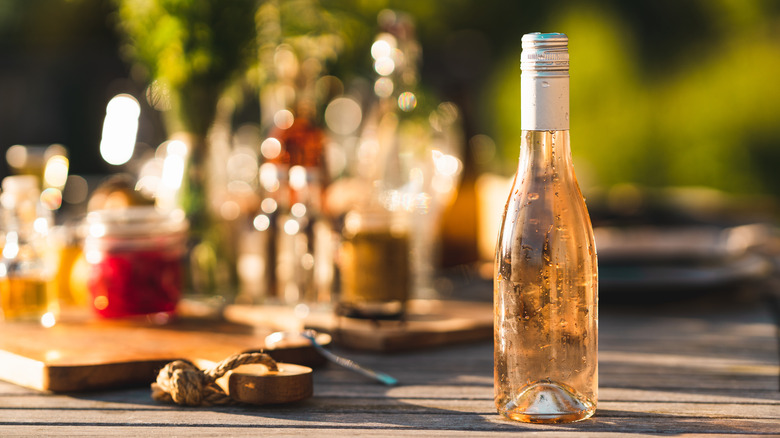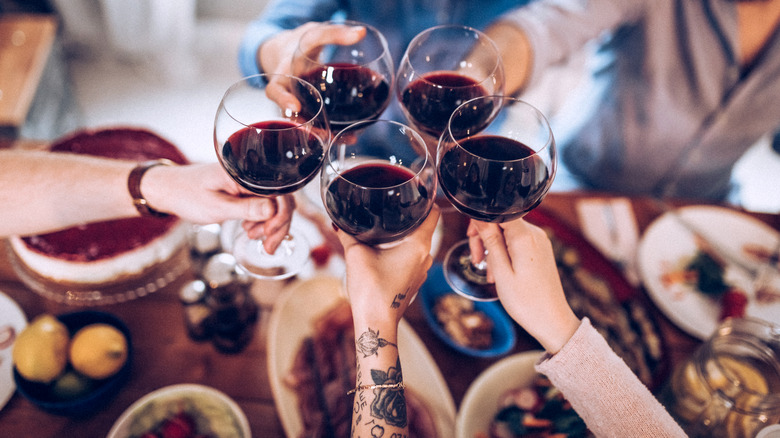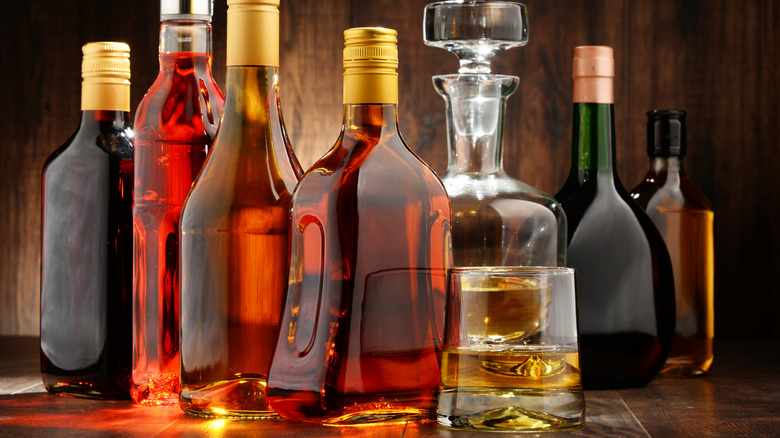Reuse Liquor Bottles For Easy Decanting At Your Next Dinner Party
Reaching the end of a 750ml liquor bottle is an event. That ornate glass bottle has been glistening glamorously on your home bar, and now, it's time to just ... throw it away? Not so fast. Breathe new life into that empty beauty and use it as a decorative wine decanter at your next dinner party.
"Decanting" may sound fancy, but it just refers to transferring wine from the original bottle in which it was purchased into another vessel. The key here is aeration. Introducing oxygen to your wine opens up its natural flavor notes, letting it breathe. All in all, it makes for a more aromatic, softened, dimensional sip. Decanting also separates the wine from the natural sediments that settle at the bottom of the bottle. Sediments are a natural byproduct, but they can affect the tasting profile of your delicate vino, adding unpleasant bitterness. Vintage ports and older reds tend to produce the most sediments as they age.
Decanting enhances balance and expression, helps achieve clarity, prevents a gritty mouthfeel, and even aids in consistent pouring for larger numbers of guests — an aesthetically pleasing ace in the hole for easy hosting and thrifty recycling. Those empty liquor bottles bring all the apothecary vibes and vintage glamor, which could be especially cute for a themed dinner party like "1960s hors d'oeuvres" or "old Hollywood." To complete the scene, set the dinner table with softly glowing taper candles and lacy runners or doilies.
Recycling never looked (or tasted) so good
To prep the bottles, simply preheat the oven to 350 degrees, and get the tap water running hot. To clean, rinse those empty liquor bottles with hot, even boiling water, but avoid using detergents, which can impact the taste of the wine. From there, pop the cleaned bottles in the warmed oven for four to five minutes, and the adhesive label will come off with ease. Small, easily maneuverable cutlery like a sharp paring knife or a razor can be useful for removing extra tough labels. If there's any leftover sticky residue, hit the bottles with an extra minute or two in the oven and a little Goo Gone. Rubbing alcohol, WD-40, nail polish remover, vinegar, tea tree oil, and baking soda can all help get the job done, too.
For the big transfer, all you'll need are the cleaned liquor bottle, a funnel, and a fine mesh kitchen strainer. Pour the wine through the funnel and strainer into your liquor bottle in a slow stream without stopping. When you notice any visible sediment transferring to the surface of the wine, stop pouring immediately. You can dump out the remaining ounce or so of the leftover sediment-filled wine. Before using this tip, store your original bottle of wine upright for at least 24 hours so the sediments can all settle to the bottom.
Which wines to decant -- and which to skip
For a show-stopping table, use liquor bottles with fun shapes or ornate designs, like di Amore amaretto or The River Test Distillery's London Dry Gin. You could even tie the neck of the bottle with a decorative ribbon bow. Not into wine? This tip also works for batched cocktails or just drinking water.
This reimagined decanter may be primarily about aesthetics, but it's also utilitarian for younger red wines, which tote the strongest tannins and benefit the most from vigorous aeration. In the wine world, "young" refers to any bottle released and consumed within 1 to 3 years of its production. For optimal results, decant young wines into your liquor bottles six hours before guests are scheduled to arrive so they'll have an adequate chance to oxygenate and open up.
Skip this tip for sparkling wines, which lose much of their fizziness in decanting. Low-tannin varieties can be similarly damaged by too much aeration. White wines can benefit from a little aeration, but they start to lose their quality after three or four hours in a decanter. Know your bottle before you decide whether to use it for this tip.


